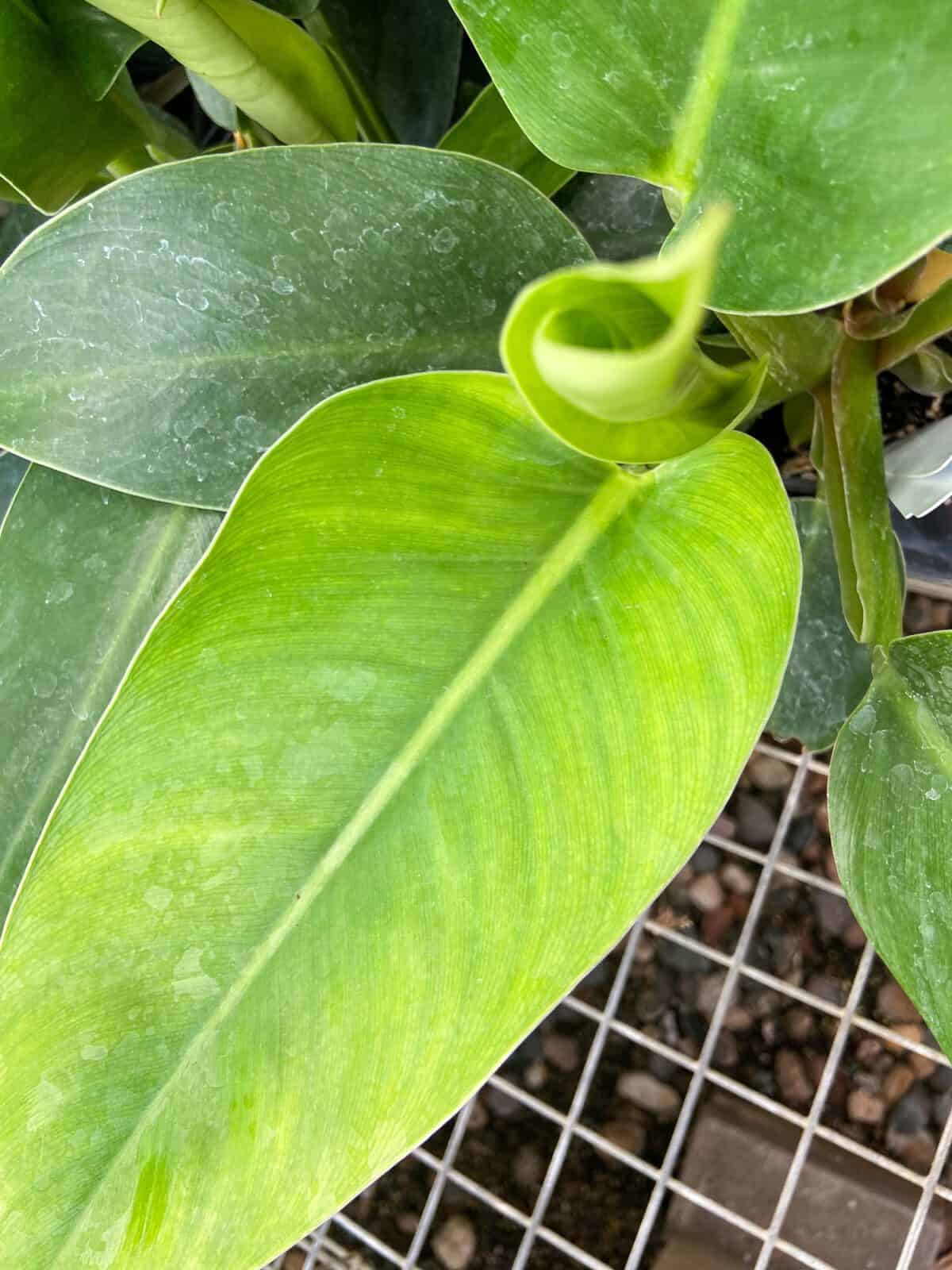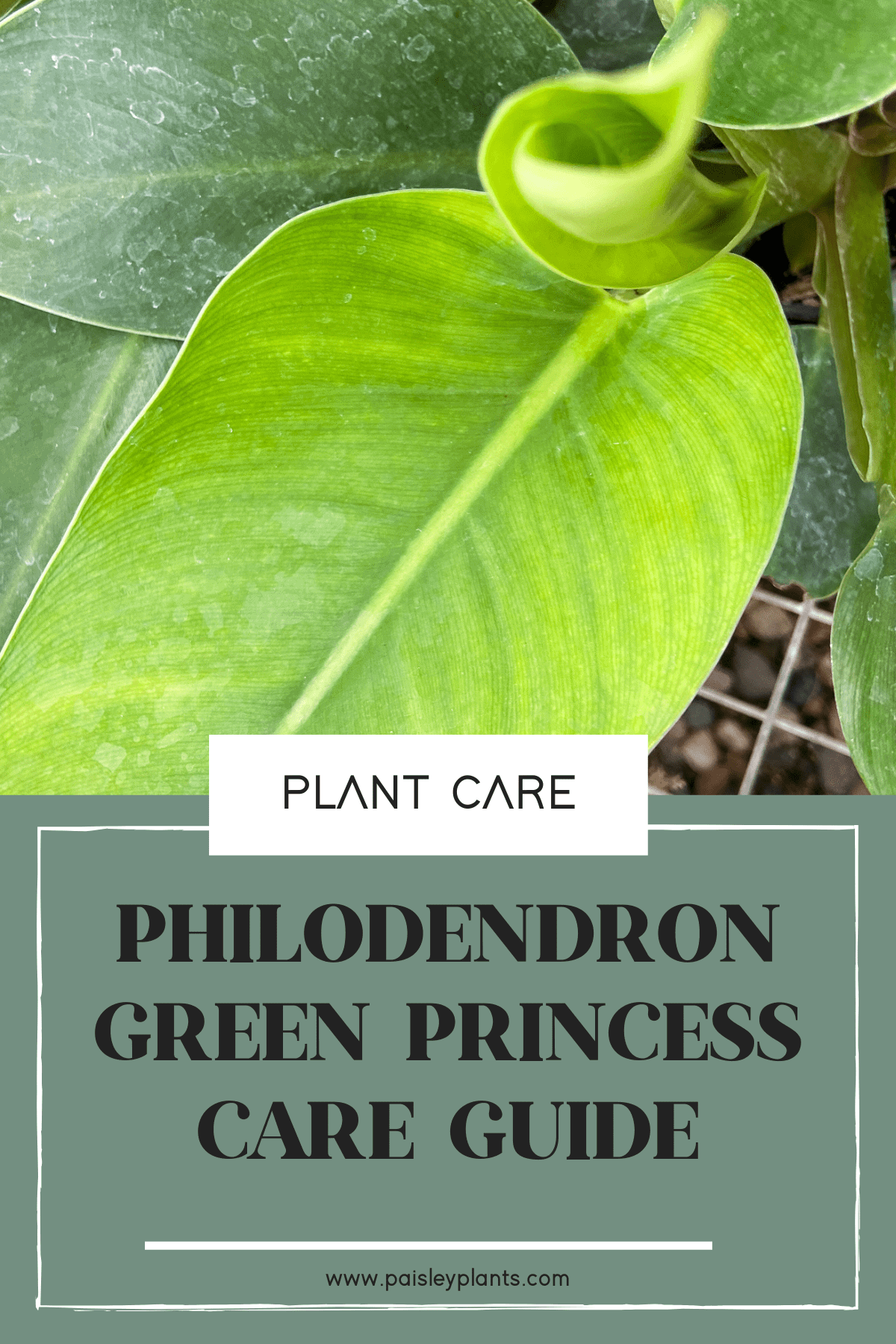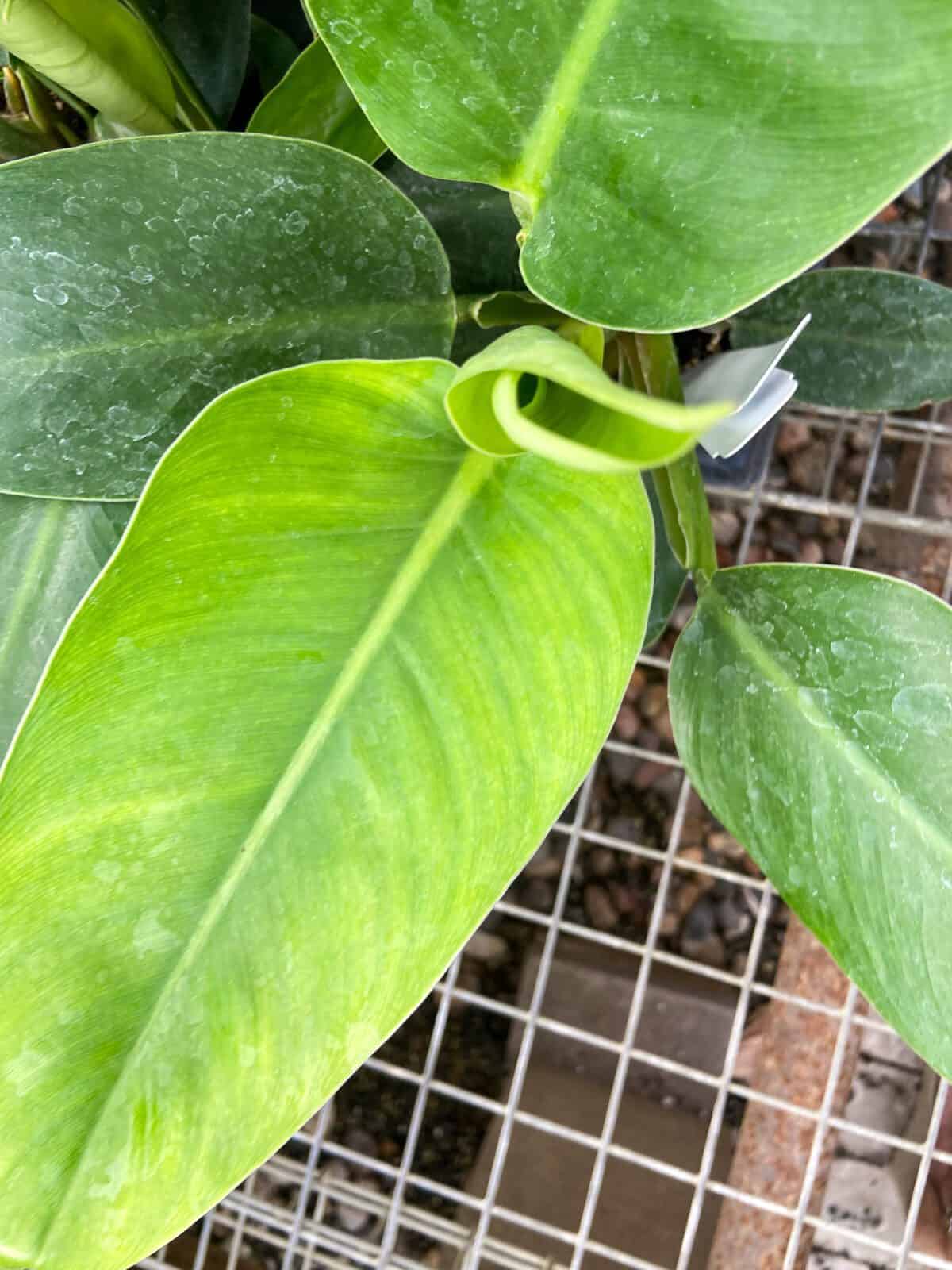It has the word “princess” in its name, but by no means is the philodendron green princess a high maintenance plant! Read on for an in-depth guide on this unique and rare member of the philodendrons.
Table of Contents
Background
The Philodendron selloum “Green Princess” originates from the rainforests of South America. The green princess is a philodendron hybrid and is closely related to the birkin variety of philodendron.
The name Philodendron comes from the Greek word phileo, meaning “to love” and dendron meaning “tree.” It is often referred to as the royal jewel of houseplants with its glossy emerald leaves and easy to care for nature.

It is one of the smaller members of the Philodendron genus, measuring at around 12 to 24 inches at full maturity. Its leaves are identifiable by their shiny, long, pointed, heart shape and have a glossy, dark green hue.
The green princess is a self-heading philodendron which means that it grows upright, not trailing, vining, or climbing. It is tree like with stiff sturdy stems that keep the plant vertical.
This plant has been designed to showcase its simplistic, but beautiful foliage, while only growing to a limited height, as stated above. The combination of its beauty and small size makes it a welcome addition to any houseplant collection.
Philodendron filter airborne toxins such as formaldehyde and trichloroethylene from the air and are considered to be air purifying plants.
All members of the Philodendron genus are toxic if ingested to both humans and animals. Philodendrons contain a substance known as calcium oxalate crystals. When ingested, these crystals can cause an array of intestinal distress.
The plant is not toxic when you touch it, but becomes toxic when ingested. For the safety of those around you, it is recommended you keep your philodendron far away from any curious children or pets.
Philodendron Green Princess Care

Sun & Light
The green princess prefers bright, indirect light conditions, though it is also tolerable of low, partial shade as well. The most important thing to keep in mind is to avoid direct sunlight.
Bright, filtered light (imitating what this plant receives in nature) is best. However, early morning or late afternoon sun is beneficial when growing your green princess philodendron indoors.
Exposure to direct sun can irreparably damage your plant’s leaves, causing them to become crisp and burnt.
Remember, the less light it receives, the slower it will grow. Also, it won’t produce as many leaves and may sometimes develop smaller leaves compared to those in brighter conditions.
Soil Type
When selecting a potting mix for your green princess, look for a mix that is tailored toward aroid plants. An aroid potting mix is light and well-draining, while still retaining enough moisture to keep your plants happy and hydrated.
We recommend avoiding any mixes that are too heavy with clay, as this can stifle the root growth of your plant. The potting mix needs to be able to retain moisture, but not hold water.
This plant prefers chunky potting mixes to provide plenty of air circulation to the root system. You can amend your all purpose potting mix with perlite and orchid bark to provide better air circulation for the roots.
Watering

Your philodendron’s soil should be consistently moist, but never saturated with water. Not too wet, not too dry. A good rule of thumb when watering your philodendron is to wait until the top 1 to 2 inches of soil has dried up before watering your plant again.
You can test the soil moisture by sticking your finger into the soil. If it is dry to the touch a few inches into the soil, then it should be watered.
The roots do not like to be left wet or soggy, so be sure your pot has good drainage. It is better to err on the side of underwatering this plant as philodendrons do not like to be waterlogged.
Fertilizer
Your green princess philodendron will benefit greatly with a diluted fertilizer solution. Select a fertilizer that has a balanced NPK (nitrogen/phosphorus/ potassium) ratio and dilute it to half strength. Feed your plant once per month during the spring and summer when your plant is actively growing.
Avoid feeding your plant altogether during the fall and winter. At this time, your plant will be in its dormant period and will have no use for fertilizer. The unused fertilizer will acidify the soil to an uninhabitable level.
Temperature & Humidity
Like many other philodendrons, the green princess loves to live in warm, humid climates. This would be an air temperature that is in the 60° to 85° F range.
Regarding humidity, you should try to maintain a level that is 50% or higher. If your home is on the dry side, you can increase the humidity by introducing a pebble tray or an electric humidifier to your home.
Misting your green princess is helpful in order to keep the leaves moist and clean. This will also help them remain dust free, which ensures that the leaves can breathe better.
The philodendron green princess needs enough illumination from light for it to grow via photosynthesis. Lack of light (even due to dirty leaves) will stunt the growth of the plant.
Pruning & Maintenance
Prune your plant whenever you notice any branches or foliage have become dead or damaged. Removing any unnecessary parts of the plant will help your philodendron redirect its energy towards developing new, healthy growth.
If the leaves on your philodendron green princess become yellow, they need to be removed. This is most likely due to overwatering. They will not return to their original green color because they have already lost the chlorophyll that makes them green and nothing can return that.
We recommend wearing gloves when cutting into a philodendron. Due to the irritants in the plant, some residual sap can cause skin irritation if it comes in contact with your skin.
Choosing a Pot & Repotting Philodendrons
Like all other aroid plants, your philodendron green princess requires a pot with drainage holes to prevent the soil from becoming too wet. Philodendrons are at a high risk of root rot when they have been overwatered.
The combination of the proper soil and using a well-draining pot are two steps you can take to avoid root rot from harming your plant.
The green princess is a fast-growing philodendron. You may need to repot your plant every 1 to 2 years. When you notice roots peeking out from the drainage holes, you should repot it as soon as possible.
When transplanting your philodendron into a new pot, size up very gradually. Select a pot that is only a few inches larger than the previous pot.
How to Propagate a Philodendron Green Princess Plant
The easiest and most practical way to propagate your green princess is via stem cuttings. Follow these easy steps to multiply your philodendron:
- Select a healthy, mature segment from your plant. Be sure to cut at least one leaf node, and 2 to 3 leaves.
- Make a cut just below the leaf node with a sterile pair of shears.
- Fill a small jar or propagation station of water and place the cutting in the jar. Be sure that the leaves are still above the rim of the glass so that there is airflow.
- Place the jar in a location of the house with indirect bright light like a windowsill. Replenish the water in the jar once a week to prevent bacteria build-up.
- It takes roughly 4 weeks for roots to begin to form from the cut-end of the stem. Wait until your green princess roots are at least 1 inch in length before transferring the cutting to a pot.
- Fill a small pot with well-draining soil. Dip the root end of the cutting into hormone rooting powder and place the cutting into the soil.
- Give the cutting a thorough watering in order to lessen the effects of transplant shock. It is not uncommon for a plant to be droopy after transplanting.
- Keep the soil uniformly moist and maintain the same light; it takes a few weeks for your stem cutting to establish itself in the soil.
Common Pests
Common pests that can attack your philodendron include aphids, mealybugs, and spider mites. While these pests can be an inconvenience to you, there are simple methods that will help eradicate your pest problem.
Many gardeners swear by neem oil to help control their pest problem. Neem oil is an organic, horticultural oil that acts as a natural pesticide.
You should spray your affected plants with the neem oil solution. Mix the solution following the instructions on the neem oil container.
Keep in mind that this is not a one-and-done method of pest control; you may have to spray your plant 2 to 3 times in order to completely rid your plants of pests. You can purchase neem oil in garden centers or it can also be purchased online.
Common Diseases
Philodendrons are very susceptible to root rot and the green princess unfortunately is no exception. In plants that enjoy consistent moisture, it can be very easy to overwater your plant.
This surplus water is counterproductive to the health of your plant, and when it does not evaporate/drain fast enough, it can cause problems.
The excess moisture that is trapped within the root system will cause the roots of the plant to corrode and rot, which will slowly kill the plant itself. If your philodendron is wilting and discolored, those are clear signs of root rot.
Fortunately, root rot can be easily treated as long as it is caught early. Follow these steps in order to treat your plant:
- Remove the plant from its pot and inspect the root system. Rotten roots are soft in texture and have turned near-black from the rot.
- Use a sterile pair of shears to cut away at all signs of rot.
- When all rot has been cut away, repot your plant in a sterile plant pot that has multiple drainage holes. Fill the planter with an aroid soil that is very well-draining.
- For the next couple of weeks, keep the soil lightly moist; this helps mitigate the effects of shock your plant sustained during treatment.
Should I clean my philodendron’s leaves?
Yes. Over time, your plant’s leaves may accumulate dirt and water spots; this is even more apparent against the naturally glossy surface of the green princess’ leaves. This dirt build-up can actually affect your plant’s rate of photosynthesis, which it requires to feed itself.
You should regularly wipe the plants leaves with a damp soft cloth or give it a full shower every now and then to remove any dust that has accumulated on the leaves. This will also help ensure you have a healthy, pest free plant.
Yes, this is one of the rarer philodendrons. However, propagation is incredibly easy and can be done at home by simply rooting plant cuttings in water. So if you find one green princess out there, you can make multiple plants at home at no extra cost!
Despite its royal-sounding name, you’ll be pleasantly surprised by how easy it is to care for the philodendron green princess. Its glossy green leaves make for a beautiful centerpiece to any home decor.
The green princess philodendron will give a lush tropical vibe to your living space. If you have the opportunity to buy one, don’t miss out!

